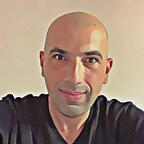The Internet’s N² Problem.
Alan Kay had told me that to understand Croquet, one had to start by reading David P. Reed’s MIT thesis “Naming and Synchronization in a Decentralized Computer System.” (1979)
While reading David’s paper, I was struggling to understand the bigger picture, and I asked him some questions after Alan introduced me to him. David took the time to explain complex ideas, and as I read his responses, I imagined how many years it would take me to fully understand them. All I knew is that it was a different point of view about how the Internet should have been. Like Minsky said, understanding something means you understand it from different points of view. But I wasn’t sure that I even understood the Internet in its present form.
I would wait for clues to appear, and a few weeks later, luck served me some understanding. I was watching Alan’s talk at the Etech Conference in 2003, and just before showing a live demo of Croquet with David A. Smith, Alan explained how the Internet steered Doug Engelbart’s ideas off-course:
“The Internet itself was designed to solve an N-squared problem, which is how to do point-to-point communication without having a crossbar switch. So it’s done using peer-to-peer. When it was done in the late sixties and seventies, it was realized that it was going to make Engelbart’s immersive stuff really really difficult, because Engelbart’s stuff –– collaboration –– was done through a server, and there are unfortunately 2-to-the-N possible subgroups in a network of N people. So this is not a scalable idea, it’s much less scalable than N-squared. And so David P. Reed and other people started thinking about how could you do this 2-to-the-N problem as a completely peer-to-peer non-server way of doing things.”
After transcribing Alan’s words, I emailed him and David P. Reed to share my newfound understanding. Alan replied:
“And in fact, the 2 to the N groups idea as the real power of the Internet is sometimes called “Reed’s Law”.
It sounded like the Internet’s design could not accommodate Engelbart’s ideas of collaboration, and David P. Reed had taken on the task of finding a solution, which was named “Reed’s Law.” Still though, I was concerned with understanding the end-user implications from an interface and experience perspective. What did all this mean in the context of how a better Internet would look and work? So I wrote to Alan and David again. Alan answered:
“Engelbart got to a number of important ideas and issues regarding interactive computing very early in the game, and this included the idea that a lot of non-linear synergies happen when people find ways to cooperate with each other. He started in an age of mainframes, and the idea from that time that these would be expanded into “interactive information processing utilities” that would be generally available to all — in analogy to the water, electricity, telephone, etc utilities.
Some of the ways this could play out were shown in 1968 — in the “big demo” — and in the paper by Licklider and Taylor — “Computers As Communications Devices.” By this time it was starting to become clear that the interactions that were most desirable would require “personal computers” for each user that would also be connected into the information utilities that would be provided by the ARPA/Internet. The scalings to soon arrive etc meant that quite a bit of the needed computing would be distributed in various ways — and that this posed some new problems for various kinds of computing, including sharing.”
David was a key player in the thinking about the Internet in the 70s, and started to ponder what would effectively be an OS for the whole Internet that could provide these needs might look like…”
I knew that there wouldn’t be clear answers, because the next iteration of the Internet hadn’t been created yet. But I knew that David A. Smith’s statement that “Croquet is the engine for the next computer vehicle” meant that the next Internet would likely be designed to work with Croquet’s engine.
Once again, I had been able to understand past events a little better, and I could see the future with more clarity. The computer revolution hadn’t happened yet, but it was happening. This clue was another moment of microscopic discovery and joy of understanding something a little better.
I knew that David A. Smith was now carrying the torch that Doug Engelbart, Alan Kay, and many others had lit. And I wanted to help him keep it lit.
Croquet
- Croquet website
- The Croquet Project Wikipedia page
- Croquet — A Collaboration System Architecture (David A. Smith, Alan Kay, Andreas Raab, David P. Reed, 2003)
- Croquet — A Menagerie of New User Interfaces (David A. Smith, Andreas Raab, David P. Reed, Alan Kay, 2004)
History of Computing Ideas
- Man Computer Symbiosis (J. C. R. Licklider, 1960)
- Augmenting Human Intellect: A Conceptual Framework (Doug Engelbart, 1962)
- The Computer as a Communication Device (J.C.R. Licklider and Robert W. Taylor, 1968)
- Naming and Synchronization in a Decentralized Computer System (David P. Reed, 1979)
Alan Kay
- Viewpoint Research Institute papers
- The Early History of Smalltalk (Alan Kay, 1993)
- Alan Kay talks
- Smalltalk Wikipedia page
- Etoys educational tool
- Squeak programming language
- Scratch programming language for children
Stories I’ve Written
- The Button on the Radio
- Shhh…The Real Computer Revolution Hasn’t Happened Yet
- Keeping Maria Montessori Alive
- Keeping Doug Engelbart Alive
Thank You
The computer revolution has barely started, and there are so many people to thank.
